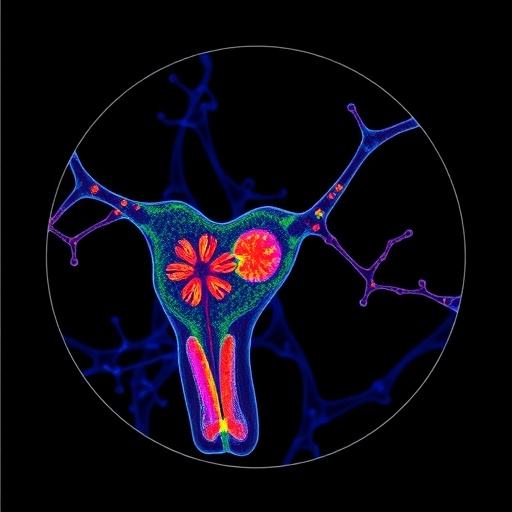In a groundbreaking synthesis of existing research, a recent systematic review and meta-analysis has revealed that elevated expression levels of small nucleolar RNA host genes (SNHGs) are significantly correlated with poorer prognosis in patients with cervical cancer (CC). This comprehensive study dives deeply into the molecular dynamics of SNHGs, a subset of long non-coding RNAs (lncRNAs), which have emerged as crucial players in tumor biology and cancer progression. As cervical cancer remains a major global health challenge, uncovering new molecular markers such as SNHGs offers hope for improved prognostic assessments and novel therapeutic targets.
The investigators meticulously searched six prominent electronic databases to collect relevant original research articles that explored the role of SNHG expression in cervical cancer. Each study was evaluated rigorously using the Newcastle–Ottawa Scale (NOS) to ensure high research quality. Key data points extracted included SNHG expression levels, patient survival outcomes, and clinical pathological features such as tumor-node-metastasis (TNM) stage, tumor size, and lymph node metastasis. These parameters were statistically synthesized through hazard ratios (HRs) and odds ratios (ORs) with corresponding 95% confidence intervals (CIs) to ascertain the association between SNHG expression and clinical outcome measures.
A striking finding from the pooled data was that higher SNHG expression nearly doubled the risk of poor overall survival (OS) in cervical cancer patients, as indicated by a combined HR of 2.046 with a robust 95% confidence interval ranging from 1.402 to 2.691. This statistically significant association firmly positions SNHGs as promising prognostic biomarkers. Given the intricate biology of lncRNAs and SNHGs, their upregulation might underpin mechanisms that favor aggressive tumor behavior, contribute to immune evasion, or foster resistance to standard therapies.
.adsslot_uek0xqZDQ8{ width:728px !important; height:90px !important; }
@media (max-width:1199px) { .adsslot_uek0xqZDQ8{ width:468px !important; height:60px !important; } }
@media (max-width:767px) { .adsslot_uek0xqZDQ8{ width:320px !important; height:50px !important; } }
ADVERTISEMENT
Notably, the meta-analysis further demonstrated that elevated SNHG expression correlates strongly with more advanced disease states. Specifically, higher SNHG levels were associated with advanced TNM stages (OR: 1.476), increased likelihood of lymph node metastasis (OR: 1.614), and larger tumor sizes (OR: 1.299). These findings highlight the role of SNHGs not just as a passive marker but potentially as an active participant in tumor progression pathways. The association with lymph node metastasis is particularly consequential, as this feature frequently signals poorer clinical outcomes and challenges in treatment management.
Interestingly, the study did not find significant associations between SNHG expression and other clinical characteristics such as histological grade, distant metastasis (DM), depth of invasion, or patient age. This suggests a more nuanced role for SNHGs that may be context-dependent or modulated by specific tumor microenvironment factors. The lack of significant correlation with distant metastasis despite the link to lymph node spread hints at potentially distinct molecular mechanisms regulating local versus systemic dissemination in cervical cancer.
One of the key strengths of this investigation lies in its robust methodological approach. The researchers conducted sensitivity analyses to confirm the reliability and stability of their overall survival findings. Additionally, Begg’s test was applied to evaluate publication bias, with results suggesting the absence of significant bias among the included studies. These quality control measures enhance the credibility of the conclusions and underscore the potential translational relevance of SNHGs in clinical oncology.
The molecular underpinnings driving the upregulation of SNHGs in cervical cancer remain an active area of research. Emerging evidence indicates that SNHGs can modulate gene expression and signaling pathways critical to cell proliferation, apoptosis, epithelial-mesenchymal transition (EMT), and angiogenesis. Their involvement in chromatin remodeling and interaction with microRNAs further underscores their multifaceted roles in malignancy. As non-coding RNAs, SNHGs do not code for proteins but influence cellular behavior through diverse mechanisms including RNA scaffolding and molecular sponging.
The translational potential of these findings extends to diagnostic development as well. SNHG levels could be measured from tumor biopsies or potentially from circulating tumor cells or extracellular vesicles in blood, enabling minimally invasive prognostic assessments. Advances in liquid biopsy technologies might therefore facilitate dynamic monitoring of SNHGs during disease progression or treatment response.
Cervical cancer’s burden remains disproportionately high in low- and middle-income countries where access to advanced screening and treatment options is limited. Thus, understanding molecular biomarkers such as SNHGs could contribute to global cancer control strategies. Biomarker-driven risk stratification might optimize resource allocation and tailor interventions in underserved populations, ultimately improving survival rates.
Despite these compelling insights, the authors acknowledge several limitations inherent to meta-analyses. Variability among included studies in terms of patient populations, SNHG expression detection methods, and follow-up durations could influence pooled estimates. Standardization of SNHG measurement techniques and prospective validation in large, multi-center cohorts are essential next steps to translate these findings into clinical practice reliably.
Furthermore, mechanistic studies are warranted to dissect the specific biological pathways through which SNHGs contribute to cervical tumor initiation and progression. Such research could reveal novel nodes for therapeutic intervention and deepen our understanding of cervical carcinogenesis. Integration with other molecular markers and clinical parameters may also yield composite prognostic models with superior predictive power.
In conclusion, this exhaustive meta-analysis shines a spotlight on the pivotal role of small nucleolar RNA host genes in cervical cancer prognosis. By linking elevated SNHG expression to poorer overall survival and more aggressive disease characteristics, it establishes SNHGs as both valuable prognostic markers and potential therapeutic targets. As the molecular landscape of cervical cancer continues to unfold, SNHG-focused research promises to enhance prognostication, guide individualized therapies, and ultimately improve patient outcomes on a global scale.
Continued research efforts marrying molecular biology, bioinformatics, and clinical oncology are critical to unlocking the full potential of SNHGs in the fight against cervical cancer. This evolving narrative adds a vital chapter in our understanding of long non-coding RNAs and their emerging importance in human malignancies, signaling a future where SNHGs may become central to cervical cancer management and therapy.
Subject of Research: The prognostic significance and clinical correlations of small nucleolar RNA host genes (SNHGs) expression in cervical cancer.
Article Title: High SNHG expression may contribute to poor cervical cancer prognosis, based on systematic reviews and meta-analyses.
Article References:
Zhang, Z., Wu, H., Huang, Y. et al. High SNHG expression may contribute to poor cervical cancer prognosis, based on systematic reviews and meta-analyses. BMC Cancer 25, 1350 (2025). https://doi.org/10.1186/s12885-025-14497-y
Image Credits: Scienmag.com
DOI: https://doi.org/10.1186/s12885-025-14497-y
Tags: cancer progression biomarkerscervical cancer prognostic markersclinical pathological features of cervical cancerhigh SNHG levels cervical cancer prognosislncRNAs in tumor biologymolecular dynamics of SNHGspatient survival outcomes cervical cancerresearch quality assessment in oncologysmall nucleolar RNA host genessystematic review and meta-analysistherapeutic targets for cervical cancertumor-node-metastasis stage





